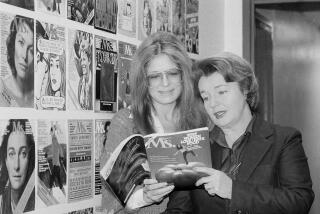THE NEW WOMEN AND THE OLD MEN Love, Sex and the Woman Question<i> by Ruth Brandon (W. W. Norton: $19.95; 294 pp.) </i>
- Share via
The most interesting times in history are those at the seams--when old worlds implode, when accepted points of view begin to collapse under the weight of new ideas. Ruth Brandon has captured such a time in “The New Women and the Old Men,” and it makes for fascinating reading (not least because one of her central subjects is sex). By focusing on a number of celebrated couplings in the decades surrounding the turn of the century--Rebecca West with H. G. Wells, novelist Olive Schreiner with “sexologist” Havelock Ellis, Karl Marx’s daughter Eleanor with the notorious scoundrel Edward Aveling, to name three--Brandon demonstrates that when it came to relations between the sexes, even the most radical of late Victorian progressives were quite conservative. Wells and Ellis, for example, believed in sexual equality and regularly championed polygamy and polysexuality, respectively . . yet also managed to glorify the joys of motherhood while refusing to tolerate children in their own households. The New Men took much pride in meshing practice with new theory, but very often succeeded only at the expense of their female lovers.
Brandon refers to this double standard, in Wells’ case, as a form of “moral acrobatics,” and much of the fun of “The New Women and the Old Men” comes from the guilty pleasure of reading about devotion and treachery in others. The greatest pleasure, however, lies in the characters themselves, for all are vibrant, larger than life. We see a fair bit of Bernard Shaw and Sidney and Beatrice Webb, but we also get Schreiner, a South African who dropped Cecil Rhodes over his pro-white politics; birth-control advocate Margaret Sanger, who had affairs with both Ellis and Wells; and indirectly, sex researcher James Hinton, who once said: “Jesus was the savior of men, but I am the savior of women.” The “Woman Question” obsesses everyone portrayed here, and their attempts to solve this literally man-made riddle are often comical.
The merit of books like this inevitably depends on the author’s treatment of the material, and fortunately it proves to be in fine hands. Although the perspective is conspicuously feminist, Brandon is scrupulously evenhanded; there’s no battle of the sexes here, only individuals trying to carve out identities in a strait-laced society. “The New Women and the Old Men” deserves a wide audience, for it is fresh, intriguing, and likely to encourage much speculation about the “natural” roles of men and women.
More to Read
Sign up for our Book Club newsletter
Get the latest news, events and more from the Los Angeles Times Book Club, and help us get L.A. reading and talking.
You may occasionally receive promotional content from the Los Angeles Times.









